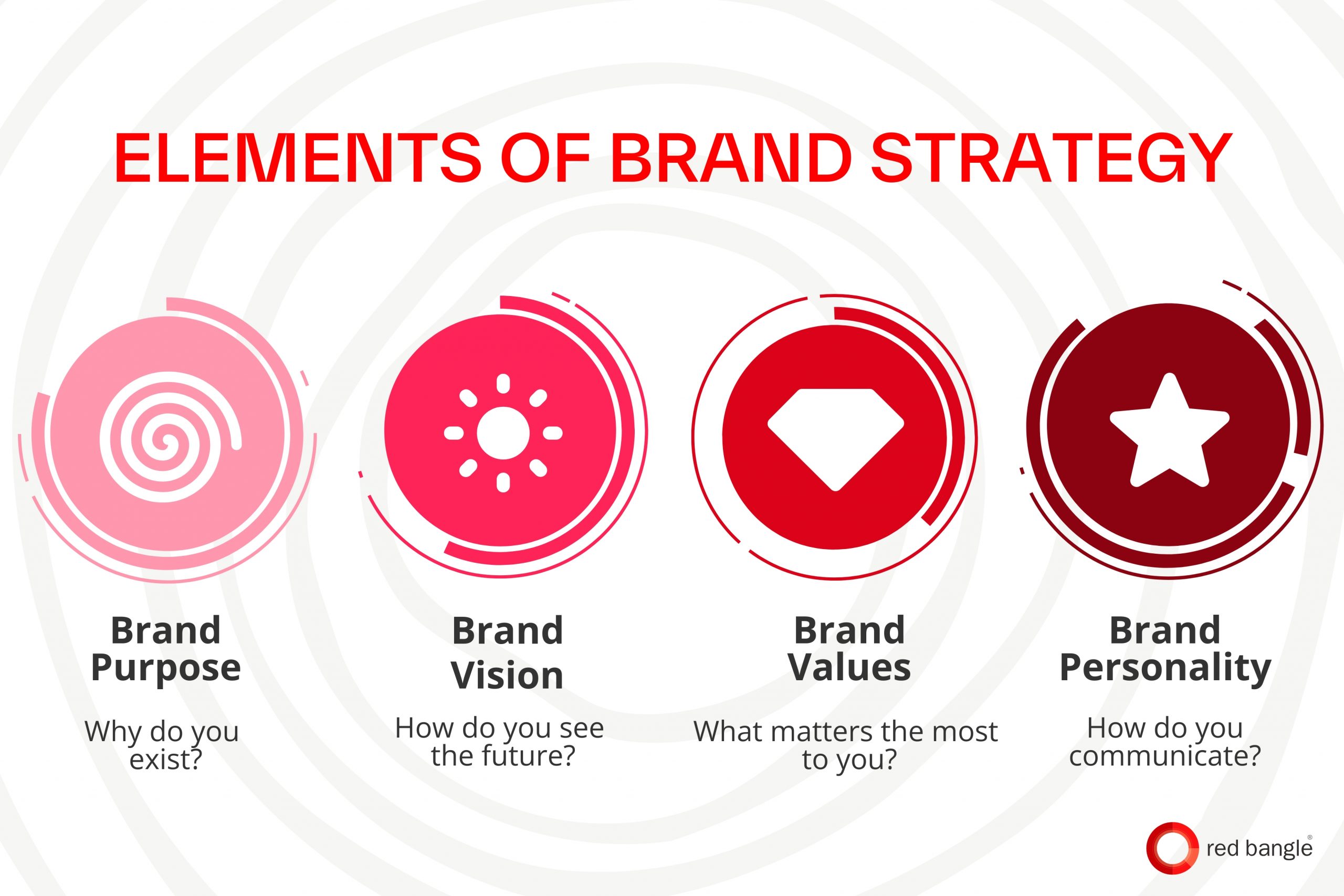How to Develop a Winning Brand Strategy
In a sea of brands constantly vying for attention, how do you stand out? Merely shouting louder into the void isn’t the answer. What you need is a winning brand strategy. But how do you develop one, and why is it crucial? Find all the answers right here…
By Mohammed for Red Bangle
10 min read
Mar 20, 2024

On a daily basis, whether we realize it or not, we find ourselves surrounded by brand experiences — be it the products we buy, the billboards lining the streets, or the advertisements displayed on auto rickshaws and trucks. Not to forget the constant stream of ads on our screens. In this vast ocean of brands, some we love, others, not so much. What is undeniable is that – in most cases, they leave a mark. – some feel like an extension of ourselves, some inspire trust, and some address a need so effortlessly that they become synonymous with the product category. Think – Xerox and not photocopy, Band-aid and not bandage, or the infamous phrase for searching online – Google it.
The question is why and how do we form connections with brands? What makes these brands so persuasive? More importantly, how can you make your brand equally influential?
You start with a solid Brand Strategy, a 360-approach to marketing that defines your mission, commitments to customers, and communication methods. This can have multiple arms and legs – like Purpose, Vision, Values, Visual Identity, Voice and more. . It is the backbone of how a business becomes distinctly recognisable, builds value, and cultivates lasting connections with its audience. 94% of consumers say they recommend brands they have an emotional connection with. It’s the go-to guide that answers questions about how the brand presents itself, essentially defining its core identity, directing decisions on brand aesthetic, communication, and behavior.
Elements of a Brand Strategy

1. Brand Purpose
Simon Sinek in his book – Start With Why, makes an incredible observation – People don’t buy your product they buy into your purpose. The guiding force behind it – as the title suggests is – get to the why.
Every brand is built with a purpose, and that purpose is the core essence of a brand – it goes beyond just selling products or services and making a profit; it plays a crucial role in shaping the brand’s identity and actions. It’s about contributing to a larger, meaningful cause that resonates with the values of the brand. A strong brand purpose means a stronger connection with its consumers. It serves as a guiding force, differentiates the brand and builds authenticity.
2. Brand Vision
Every brand has a grand picture it aspires to create – it’s the inspiring future that guides the brand’s journey, this becomes the brand vision. It encapsulates the long-term goals and aspirations, providing a clear direction for the brand’s growth and impact. This aspiration and brand potential draw in both employees and customers, working together to bring brand dreams to reality.
3. Brand Values
Brand values act as the guiding principles, steering the decisions and conduct that define a brand’s character. They mirror the core beliefs embraced by a company’s leaders and team, extending across their operations, industry, community, and more. These shared ideals, like diversity, sustainable sourcing, precision, and others, are purposefully selected to symbolize the principles the team holds dear. A study by Zimmer Communications found that “13% of consumers are willing to pay up to 50% more for products or services if that brand makes a positive impact on the world around them.”
4. Brand Personality
Every brand has a unique personality that defines it – distinctive traits and style that evoke a special brand personality. Crafting a personality for our brand is like creating a memorable character – it shapes how people see the brand and influences what they think about it. Brand Personality is a blend of its visual identity and voice.
Want to make sure your audience recognizes you in a glance? A powerful visual identity will do just that for you. It brings recognition and remembrance to the brand. Consumers link your visuals with what your brand stands for. Plus, a well designed visual identity is versatile and can adapt across various mediums and platforms ensuring a consistent brand representation across diverse channels.
Brand voice is akin to the tone and style of a brand’s conversation, representing how the brand articulates itself in words. A brand’s voice must be in harmony with its personality and strike a chord with the target audience, be it a formal and professional tone or a friendly, conversational one. A consistently authentic brand voice cultivates familiarity and trust, enhancing the relatability of the brand’s communication.
A brand that has cohesion in the visual identity, brand voice and values which helps bring out a strong personality and attracts audiences that are attracted to this personality.
Some examples of brands with a very clear and strong brand visual identity are Chumbak, a brand that blends desi with quirky, creating a uniquely playful combination. Then there’s Cred, a fresh finance brand that defines itself with a sleek, sophisticated, and cool identity.
How To Build a Winning Brand Strategy
So, what should you do to build a winning brand strategy? Should you take help from a Marketing Agency or Content Production Agency? Well, that could be a way to boost your content. Agencies can provide you with Holistic Marketing Agency Solutions and Content Production Services that can help you up your brand strategy and content game; or you can get those creative juices flowing and make your own content. But there are a few key points to always keep in mind. Some of them are listed here:
1. Pick your Niche
Crafting a winning brand strategy begins with a key step: choosing your niche. It’s like navigating a bustling room, finding that unique group that resonates with you,i.e instead of chasing universal appeal, the goal is to connect with a specific audience.
When your brand resonates with a specific group, it evolves beyond being a product or service; it becomes a shared experience. Catering to a niche market involves offering specialized services, serving specific audiences, or focusing on certain products that best meet your customers’ needs.
A brand that works within a very specific niche is TomBoyX, an underwear brand for the LGBTQ+ community.
2. Know your Target Audience
Who is your audience?
What are they looking for?
These are the most crucial questions you should answer.
In order to be able to influence your audience, you must know what they need and want. What motivates them to buy a particular product or service? What is their purchasing power? What age-group and geography does your audience belong to?
Streamlining your audience is a crucial step to lay the foundation for other aspects of brand development. Gaining insights into demographics, desires, behaviors, and preferences allows you to customize your offerings and messages effectively. This personalized approach goes beyond sales – it helps craft distinctive personas, defines your brand’s communication style, shapes visual design, and ensures resonance with the right audience. This way, you’re not just selling; you’re fostering meaningful connections that contribute to boosting overall sales.
3. Identify your USP
In a crowd of homogenous products, standing out is challenging.
Identifying your brand’s uniqueness and conveying it to your audiences is of utmost importance in order to build a winning brand strategy.
One must establish a unique market position as part of your brand strategy to avoid blending into the market. This distinctiveness not only creates a lasting impression but also cultivates brand loyalty, as consumers resonate with and remember the brand for its exceptional qualities; for example: Patagonia, a brand committed to using only organic cotton and collaborating with grassroots organizations to restore the environment.
4. Authenticity
Authenticity stands as the foundation of trust within a brand. When a brand operates authentically, it fosters credibility and builds a sense of loyalty among consumers. This honesty and transparency not only resonate positively with the audience by contributing to a genuine and favorable brand sentiment. In a market flooded with options, an authentic brand stands out, drawing customers who appreciate sincerity and are more likely to form enduring, positive associations with the brand.
Patagonia was awarded the world’s most authentic brand for 2023 because of their commitment to their purpose – safeguarding and nurturing the environment while exclusively utilizing organic cotton products.
5. Compelling Storytelling
The most important part of building a brand is taking that brand to your consumers. To be able to efficiently communicate with your audience is the most important skill in brand strategy. Capturing and retaining audiences’ attention isn’t easy, one needs to create interesting, engaging content. It is more than marketing products—it’s about weaving a story that delves into a brand’s values, mission, and personality. Successful storytelling goes beyond features, creating an emotional connection with the audience.
By sharing a brand’s journey, it becomes relatable, this bond extends beyond transactions, fostering a sense of community and shared values among customers. Ultimately, creating a lasting relationship based on shared beliefs and emotions.
A good example of a brand that has mastered the storytelling game is Dove. Dove not only aimed to make women feel beautiful but also fostered a global community, encouraging them not to shy away from their insecurities.
(To learn more, check out this blog – How to create engaging Storytelling Videos?)
6. Developing an Engaging Visual Identity
A distinctive Brand Logo, Brand Aesthetics such as colours and fonts and styles encapsulate the essence of your brand. A cohesive color palette that reflects the brand’s personality and consistent typography resonates with your target audience and adds to the brand’s recognizability. Design Powers’ research says that 80% is how much color improves brand recognition. Uniformity across all platforms, from your product to website to social media, reinforces brand recognition.
Engaging visual elements not only capture attention but also convey the brand’s values and personality. Your brand needs an identity that sticks in audience minds, fostering a connection with your audience.
Check out this blog by Adidas on their most obvious visual identity – their logo.
In summary, developing a winning brand strategy is a multifaceted process that guides a business’s mission, promises, and communication. These components including purpose, vision, values, personality, and voice, collectively shape a cohesive and authentic brand identity. Crafting a distinct personality, voice, and engaging visual identity enhances brand recognition and fosters emotional connections. Choosing a niche, understanding the target audience, and identifying a unique selling proposition are pivotal steps in differentiating the brand in a crowded marketplace. By aligning these elements seamlessly, businesses can establish a powerful and memorable brand presence.
Remember, brands can’t do it all alone; they need partners to execute their strategy. Integrated Marketing Agencies are your strategic storytellers armed with Holistic Marketing Agency Solutions and Brand Strategy prowess. Their market analysis helps understand your audience and sizing up the competition, crafting a strategy that becomes your brand’s treasure map.
As your Holistic Marketing partners, they cover all platforms, be it traditional or digital, and even moonlight as a Content Production Agency, conjuring narratives and visuals that captivate consistently. Picture a world where your brand’s strategy is a captivating story, not just a plan. These agencies bring – a blend of strategy, marketing skills, and content prowess to help your brand grow wider and succeed. At Red Bangle we give you exactly what you’re looking for: the best Creative Agency Service.
Are you ready to bring your brand’s story to life? Hit the button below!


